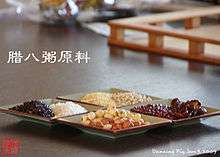Laba congee
|
Laba congee with nuts and dried fruits | |
| Type | Congee |
|---|---|
| Place of origin | China |
| Main ingredients | Many kinds of rice, beans, dried fruit, etc. |
| Variations | Variations depending on geographical regions in China |
|
| |


Laba congee (simplified Chinese: 腊八粥; traditional Chinese: 臘八粥; pinyin: làbāzhōu, also simplified Chinese: 八宝粥; traditional Chinese: 八寶粥; pinyin: bābǎozhōu) is a Chinese ceremonial congee dish eaten on the eighth day of the twelfth month in the Chinese calendar.
The day on which it is traditionally eaten is commonly known as the Laba Festival. The earliest form of this dish was cooked with red beans and has since developed into many different kinds. It is mainly made up of many kinds of rice, beans, peanuts, dried fruit, lotus seeds, etc. Depending on region-based variations in China, it can also include tofu, potato, meat and vegetables.
History
In the Han Dynasty, during the Laba Festival, people did not consume Laba congee as it was used for worshipping the gods. In the Northern and Southern Dynasties period, the date of the Laba Festival was fixed on the eighth day of the twelfth lunar month. In the Song Dynasty, Laba congee was widely consumed throughout China by not only the common people, but also government officials and aristocrats. In the Qing Dynasty, the Laba Festival was sometimes celebrated as the "Spring Festival", and Laba congee became even more popular. In the imperial court, the emperor and nobles gave Laba congee to the officials, servants, and others.[1]
Legends
There are several legends in China about the origin of the Laba congee.[2] Some of these legends are:
- The consumption of Laba congee is to commemorate the Song Dynasty general Yue Fei, who is widely regarded as a patriot and national hero in Chinese culture.
- Zhu Yuanzhang (the Hongwu Emperor), the founder of the Ming Dynasty, used to live in poverty before he rose to power. He ate congee during those hard times. After becoming the emperor, he asked the people to eat congee as well.[3]
- Siddhārtha Gautama (the Buddha) once attempted to find the right path to awakening by starving himself. One day, when he was starved and weakened, he met a village girl who gave him milk and rice pudding (congee) after mistaking him for a spirit who granted her a wish. He attained enlightenment not long after that incident.[4] (See Gautama Buddha#Awakening for the story.) The Laba congee is thus sometimes referred to as "Buddha congee" to remember this incident and the Buddha's path to enlightenment.[5]
See also
References
- ↑ (in Chinese) 腊八节在中国已有千年历史 民间有喝腊八粥习俗 (The history of the Laba Festival in China dates back to thousands of years ago. The common people had a practice of consuming Laba congee.)
- ↑ (in Chinese) 腊八节的起源与传说 (The origins and legends of the Laba Festival)
- ↑ "腊八节的由来和几个传说 (The origin of the Laba Festival and some legends related to it)" (in Chinese).
- ↑ (in Chinese) 腊八粥的故事 (The story of Laba congee)
- ↑ "佛粥的由来 (The origin of Buddha congee)" (in Chinese).
